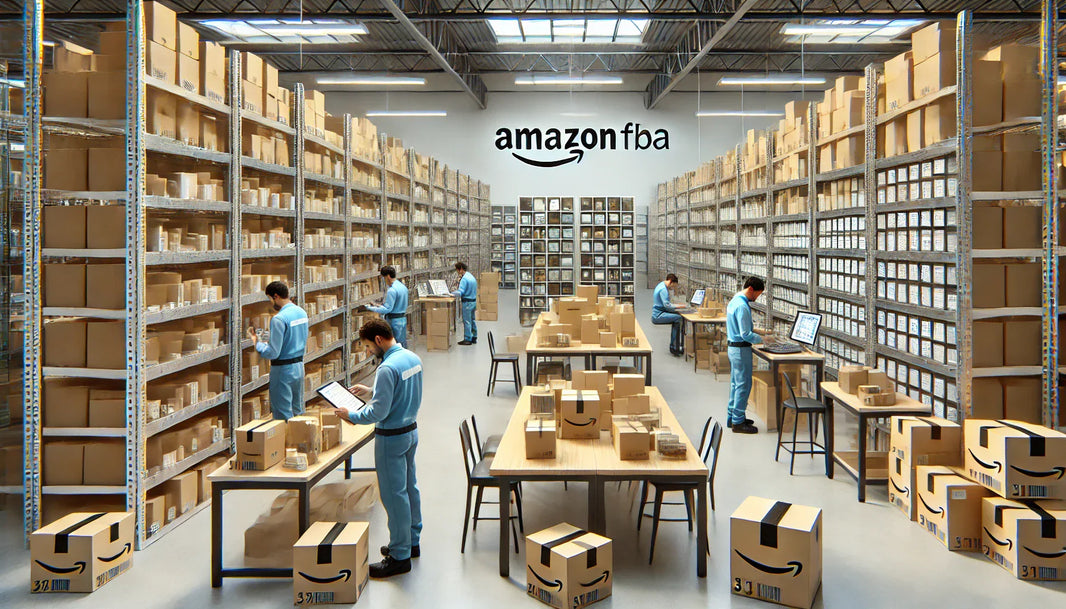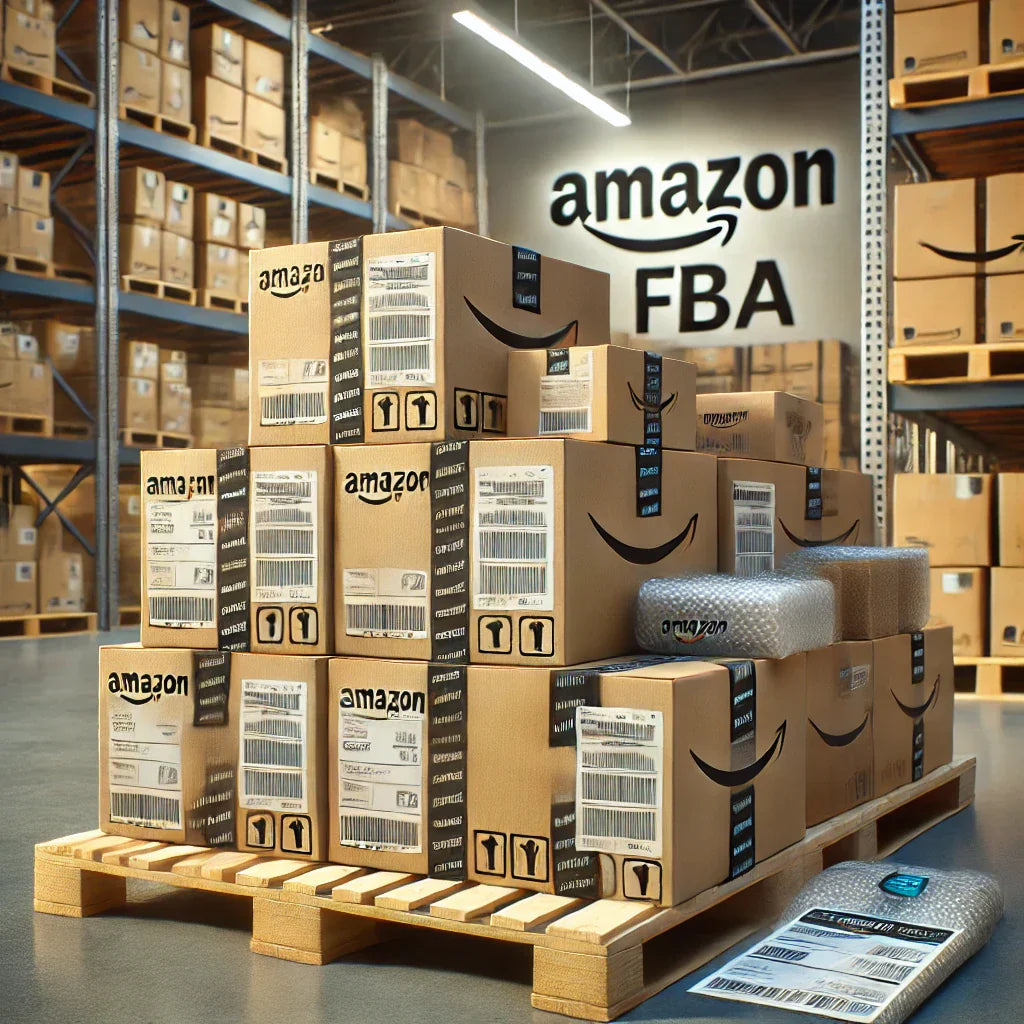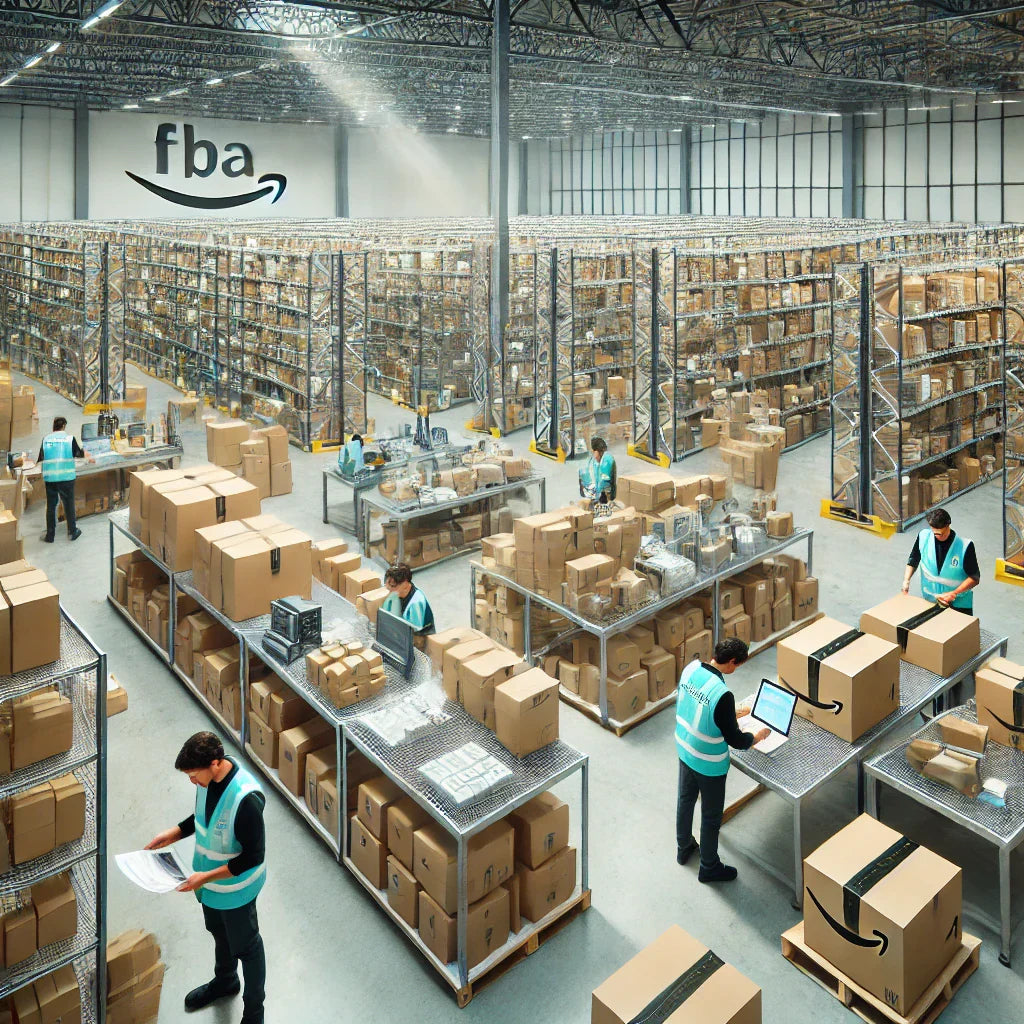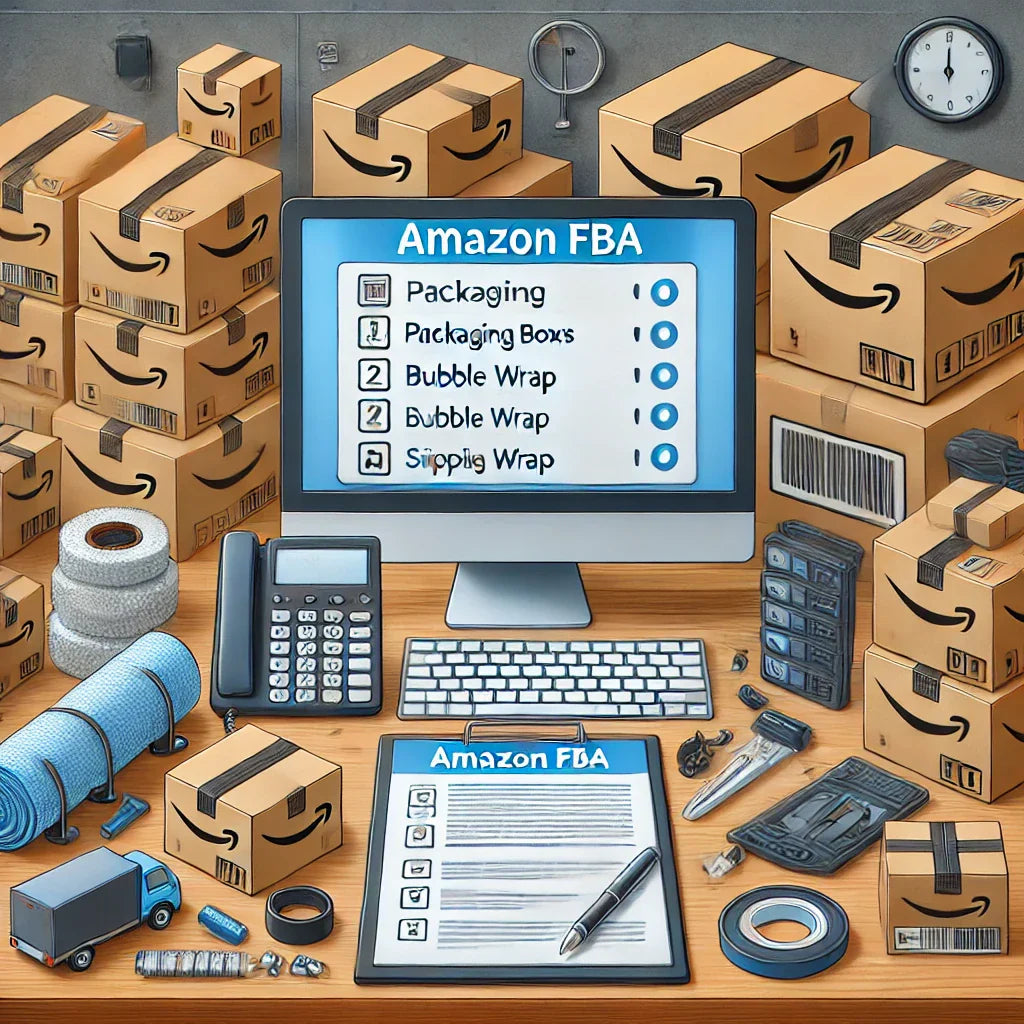Starting an Amazon FBA business can be a game-changer for aspiring entrepreneurs and established businesses alike, offering a streamlined way to reach millions of potential customers through one of the world’s largest online marketplaces. However, navigating the logistics of Amazon FBA preparation is crucial for ensuring a smooth journey from product sourcing to successful deliveries. Amazon’s stringent packaging, labeling, and shipping guidelines require careful planning and attention to detail to avoid common pitfalls that can lead to delays, increased costs, or even penalties. This comprehensive guide walks you through each step of Amazon FBA preparation, offering essential insights and best practices to help you optimize your process, meet Amazon’s requirements, and set your business up for sustained success. Whether you’re new to FBA or looking to refine your approach, these strategies will provide the foundation you need to confidently manage every aspect of Amazon FBA preparation.

1. Understanding Amazon FBA Preparation
Amazon FBA, or Fulfillment by Amazon, offers sellers the advantage of using Amazon’s logistics, including warehousing, packing, shipping, and customer service. While FBA can streamline your business, effective preparation is essential for avoiding complications with Amazon’s stringent standards.
1.1 Why Preparation Matters in Amazon FBA
With Amazon handling storage, shipping, and customer service, the seller’s responsibility is to prepare inventory according to Amazon’s requirements. Non-compliance with Amazon’s strict guidelines on labeling, packaging, and quality control can lead to inventory rejections or delays. Proper preparation streamlines the process, ensuring products reach customers efficiently.
1.2 Key Elements of Amazon FBA Preparation
Successful Amazon FBA preparation involves understanding Amazon's requirements, preparing products for safe transit, complying with Amazon’s labeling and packaging standards, and choosing suitable shipping methods.
2. Amazon Packaging Requirements: Ensuring Compliance
Amazon has detailed packaging requirements to ensure items arrive safely at Amazon fulfillment centers and ultimately to customers. Failing to follow these guidelines may lead to delays, penalties, or the need for repackaging.
2.1 Amazon’s General Packaging Standards
To ensure items are processed efficiently and protected during shipping, Amazon outlines general requirements for FBA preparation, including:
- Durability: Packaging should withstand typical shipping pressures.
- Safety: Items must be securely packed to prevent damage.
- Size Constraints: Packages must adhere to specific weight and dimension limits.
- Labeling: Proper labels help streamline Amazon’s fulfillment process.
2.2 Product-Specific Packaging Standards
Amazon has additional guidelines for specific product types. For example:
- Fragile Items: Bubble wrap or special packaging to prevent breakage.
- Liquid Products: Containers must have secure caps, and bottles should be double-sealed.
- Electronics: Static-free packaging is necessary to avoid damage.
3. Labeling Requirements: Essential for FBA Success
Proper labeling is critical in Amazon FBA preparation, as accurate labels allow Amazon to process and store items correctly. Amazon mandates that all products have unique barcodes for tracking.
3.1 Types of Required Labels
Amazon uses three main label types:
- FNSKU (Fulfillment Network Stock Keeping Unit): Every product requires an FNSKU, which is unique to each product and specific to Amazon’s fulfillment system.
- Shipping Labels: Amazon requires external shipping labels with detailed product and delivery information.
- Safety Labels: For items requiring special handling, such as electronics or hazardous materials, Amazon mandates additional labels.
3.2 Best Practices for Labeling
Using clear, accurate labels that adhere to Amazon’s guidelines is vital. Key tips include:
- Print labels with high-quality printers to ensure scannability.
- Double-check label placement to avoid obscuring barcodes.
- Use Amazon’s FBA Label Service if labeling seems overwhelming.
3.3 Avoiding Common Labeling Mistakes
Incorrect labeling can disrupt Amazon’s internal processes, potentially causing products to be mislabeled or delayed. Here are common mistakes sellers make and how to avoid them:
- Covering Barcodes: Ensure that no elements, like packaging materials or other labels, cover any barcode. If multiple barcodes are visible, Amazon may face scanning errors, resulting in delays.
- Fading or Smudged Prints: Labels must remain clear and readable through the entire fulfillment process. Use high-quality printers and inks to avoid faded or smudged prints that could impede Amazon’s scanning.
- Label Placement: Avoid placing labels on edges or corners. Amazon scanners may fail to detect barcodes on irregular surfaces. Ideally, place labels on flat, easily scannable sections of the product packaging.
3.4 Using Amazon’s FBA Label Service
Amazon’s FBA Label Service provides labeling support at an additional fee per unit. By opting for this service, Amazon’s warehouse staff will label items for you. This can be highly beneficial if:
- You’re new to FBA and prefer a seamless start.
- Your product line includes a large variety of items, making self-labeling time-consuming.
- You need assurance of compliance with Amazon’s strict labeling standards.
4. FBA Prep Centers: A Helpful Option for Sellers
While some sellers handle Amazon FBA preparation in-house, many opt to use an FBA prep center. These third-party providers specialize in preparing products according to Amazon’s exact standards, which can be highly advantageous for sellers who need to streamline operations.
4.1 What Is an FBA Prep Center?
An FBA prep center is a third-party service that handles all aspects of Amazon FBA preparation, including inspection, labeling, packaging, and shipping. Many sellers find FBA prep centers beneficial for ensuring that all products meet Amazon’s requirements.
4.2 Benefits of Using an FBA Prep Center
Using an FBA prep center offers several advantages:
- Expertise: FBA prep centers understand Amazon’s requirements, reducing the risk of non-compliance.
- Efficiency: By outsourcing preparation, sellers can focus on other areas of their business.
- Reduced Errors: Prep centers have strict quality control processes, reducing the chances of errors in packaging or labeling.
4.3 Selecting the Right FBA Prep Center
Choosing an FBA prep center requires evaluating services, costs, and turnaround times. Here are factors to consider:
- Experience with Amazon Requirements: Work with centers specializing in Amazon FBA, as they’ll have up-to-date knowledge on packaging, labeling, and shipping standards.
- Pricing Structure: FBA prep center fees vary, and they may charge per unit or by weight and size. Understanding this upfront helps in budgeting costs effectively.
- Service Flexibility: Some centers offer tiered services—basic prep, labeling only, full packaging, and even returns processing. Choose one that aligns with your needs.
- Turnaround Time: Fast preparation and shipping times can prevent stockouts at Amazon warehouses. Discuss typical processing times with your chosen center.
4.4 Common Services Offered by FBA Prep Centers
While FBA prep centers typically handle core preparation tasks, many also offer additional services to streamline Amazon FBA preparation further:
- Product Inspection: Prep centers inspect products to ensure compliance with Amazon’s standards. This can prevent potential issues with damaged items or incorrect listings.
- Kitting and Bundling: Some centers can bundle products or kits into single units. For example, if selling a set of kitchen tools, the center can combine them into one package to be sold as a set.
- Return Processing: In cases where items need to be returned, certain prep centers can handle returns, ensuring items are reconditioned, repackaged, or disposed of correctly based on Amazon’s policies.
4.5 Evaluating FBA Prep Centers for Compliance
Since Amazon’s FBA guidelines are strict, the right prep center should stay updated on all changes to Amazon’s standards. Questions to ask include:
- How does the center ensure compliance with Amazon’s latest FBA policies?
- Are there specific processes to handle Amazon’s product inspection requirements?
- What is their protocol for notifying sellers about potential compliance issues?

5. Step-by-Step Amazon FBA Preparation Process
For sellers preparing products themselves, following a clear step-by-step process can make Amazon FBA preparation easier and more efficient.
5.1 Product Inspection
Inspecting products is the first and most crucial step in FBA preparation. This involves checking for quality issues, ensuring all items match the listing descriptions, and verifying that all components are present.
5.2 Packaging Products Correctly
Using the proper packaging materials can prevent damage during transit and ensure compliance with Amazon’s standards. Here are a few best practices:
- Use durable materials like bubble wrap, air pillows, or foam.
- Make sure the packaging fits snugly to avoid movement inside.
- Consider product-specific requirements, such as adding tape to liquid containers.
5.3 Labeling and Barcoding
Each product should be labeled with an FNSKU barcode, making it scannable in Amazon’s fulfillment centers. Proper placement of labels is essential to prevent delays.
5.4 Creating a Shipping Plan
The Amazon Seller Central portal provides an option to create a shipping plan. This plan details the number of units and weight of your shipment, along with destination details.
5.5 Shipping Your Products
After creating the shipping plan, arrange shipping to the designated Amazon warehouse. Consider using a carrier familiar with Amazon FBA requirements to avoid delivery issues.
5.6 Additional Tips for Product Inspection
Effective inspection is key to ensuring customer satisfaction and reducing returns. During inspection:
- Quality Control Checklists: Create checklists that outline all product features and standards your items must meet. For example, check for blemishes, proper functioning, and completeness of parts.
- Double-Check Quantities: Verify the correct quantities to ensure no under- or over-shipping, which can cause inventory discrepancies and may result in penalties or storage issues.
- Testing Products: For items like electronics, performing basic tests (e.g., turning the device on/off, checking features) ensures quality before they reach Amazon’s warehouse.
5.7 Packaging Techniques for Fragile and Specialty Items
Different products require tailored packaging techniques. Here are additional tips:
- Fragile Items: Place items in boxes with at least two inches of padding on all sides to prevent damage from shocks or vibrations during transit.
- Perishables: If selling food or items with expiration dates, use cold packs or vacuum sealing, ensuring all expiration dates meet Amazon’s freshness requirements.
- Textiles and Apparel: Seal clothing items in clear poly bags to prevent dust and damage. Consider using resealable bags that protect the fabric while allowing inspection without complete unsealing.
5.8 Creating an Efficient Shipping Plan
An organized shipping plan helps avoid disruptions and ensure a seamless process. Here’s how to optimize it:
- Accurate Quantity Reporting: When creating the shipping plan, double-check inventory quantities to avoid discrepancies.
- Warehouse Location Strategy: Amazon may assign multiple warehouses for your shipment based on regional demand. If this happens, allocate stock according to warehouse locations to avoid added costs.
- Carrier Selection: Choose carriers familiar with Amazon’s processes. Some Amazon-partnered carriers may offer preferred rates and are more experienced with FBA requirements.
5.9 Tracking Shipments to Amazon Fulfillment Centers
Once products are shipped, monitoring their journey is essential:
- Utilize Amazon’s Tracking Dashboard: Amazon’s Seller Central provides real-time updates on shipment status, allowing you to address potential delays promptly.
- Communicate with Carriers: For large shipments, proactive communication with carriers helps mitigate issues that could delay arrival at Amazon’s fulfillment centers.
- Verify Receipt and Condition: Upon arrival, confirm that all items were received in good condition, matching your sent quantities. Amazon will notify you if there are discrepancies or damages.
6. Amazon FBA Prep Best Practices
To simplify Amazon FBA preparation, consider these best practices that streamline operations and improve efficiency.
6.1 Quality Control Checks
Inspect products before shipment to ensure they meet Amazon’s quality standards. Checking for defects, verifying quantities, and confirming that items match the listing can prevent returns and improve customer satisfaction.
6.2 Accurate Documentation
Maintaining organized records is essential for tracking inventory and shipments. Accurately documenting quantities, barcodes, and SKUs can help prevent errors in Amazon’s fulfillment process.
6.3 Partnering with Reputable FBA Prep Centers
When selecting an FBA prep center, research their reputation, service offerings, and turnaround times. A reliable prep center will offer transparent pricing and a clear understanding of Amazon’s requirements.
6.4 Inventory Forecasting and Management
Efficient inventory management minimizes storage fees and ensures sufficient stock levels to meet demand:
- Data-Driven Forecasting: Use sales data to forecast demand accurately. For instance, increased demand during holidays may warrant additional stock.
- Stock Replenishment Cycles: Schedule regular restocking to avoid overstocking, which incurs Amazon’s long-term storage fees. FBA prep centers can also support these cycles by facilitating timely restocks.
- Seasonal Product Adjustments: Adjust stock levels based on seasonal trends to ensure timely fulfillment without incurring excess storage fees.
6.5 Monitoring FBA Performance Metrics
Amazon monitors seller performance closely. Key metrics include:
- Inventory Performance Index (IPI): Amazon’s IPI score measures inventory management. A higher IPI score indicates effective stock levels and less overstock, improving fulfillment performance.
- Perfect Order Percentage: This metric evaluates your orders’ compliance with Amazon’s guidelines and customer satisfaction. Maintaining a high perfect order percentage enhances seller reputation.
- Fulfillment Costs: Tracking costs associated with FBA, such as fulfillment fees, storage fees, and removal fees, ensures that you manage expenses efficiently.
6.6 Leveraging Amazon’s FBA Tools and Reports
Amazon offers various tools to streamline FBA management:
- Restock Inventory Tool: Amazon’s Restock Inventory tool provides insights into ideal restocking quantities and timing.
- Inventory Health Report: This report offers valuable insights into excess inventory, stranded inventory, and recommended actions.
- Fee Preview Report: To manage costs effectively, review Amazon’s Fee Preview report, which details expected charges per item for storage and fulfillment.
7. Frequently Asked Questions About Amazon FBA Preparation
This section addresses common questions and concerns about Amazon FBA preparation.
7.1 What Are the Benefits of Amazon FBA?
Amazon FBA offers sellers several benefits, including access to Amazon’s vast logistics network, Prime shipping for increased visibility, and the opportunity to focus on business growth instead of warehousing and fulfillment.
7.2 How Much Do FBA Prep Centers Cost?
FBA prep centers typically charge per unit for services, with costs depending on the complexity of the preparation. Basic prep fees can range from $1 to $5 per unit, depending on the services required.
7.3 What Packaging Materials Are Allowed?
Amazon allows several types of packaging materials, but they must meet safety and durability requirements. Sellers should avoid materials that might leak, explode, or cause damage to other products.
7.4 How Can I Minimize FBA Prep Costs?
Reducing costs in Amazon FBA preparation is essential for maintaining profitability:
- Optimize Packaging: Avoid excessive packaging to minimize dimensional weight costs. Lightweight materials reduce shipping fees without compromising protection.
- Batch Labeling and Packaging: Group products by type to expedite the packaging process, especially when using an FBA prep center.
- Negotiate with Carriers: If you regularly ship high volumes, consider negotiating discounted rates with carriers.
7.5 What Should I Know About Amazon’s Hazmat and Restricted Products?
Amazon restricts certain hazardous or regulated products, making it essential to review policies if selling such items:
- Compliance with Safety Standards: Ensure hazardous items comply with local and international regulations, including proper labeling and packaging.
- Application Process for Hazmat Products: To list hazmat items on Amazon, complete the Hazmat Review process, ensuring compliance with specific storage and transportation regulations.
- Restricted Products List: Familiarize yourself with Amazon’s restricted products list to avoid potential bans or penalties.

8. Preparing for Success with Amazon FBA
Mastering Amazon FBA preparation can provide a competitive edge by minimizing errors, reducing costs, and creating a seamless experience for customers. Building a solid FBA preparation strategy requires more than just compliance with Amazon’s standards; it also involves effective management, organization, and continuous optimization to improve efficiency and profitability.
8.1 Building an Inventory Management System
Inventory management is a crucial component in FBA preparation that impacts storage costs, restocking frequency, and customer satisfaction. A robust inventory system helps sellers monitor stock levels, plan reorders, and track shipments to Amazon’s fulfillment centers.
- Using Software Tools: Consider using inventory management software that integrates with Amazon’s Seller Central. Tools like Sellbrite, InventoryLab, or Zoho Inventory allow you to monitor real-time stock levels, automate reorders, and analyze sales trends to optimize inventory.
- Set Reorder Thresholds: Avoid stockouts by setting automatic reorder thresholds for high-demand items. When inventory drops below a certain level, the system will notify you to restock, preventing sales disruptions.
- Seasonal Adjustments: Adjust reorder points based on seasonal demand fluctuations. For example, ramping up inventory before the holiday season can help capture increased sales, while scaling back after peak periods prevents overstocking.
8.2 Managing Long-Term and Short-Term Inventory Storage
Amazon FBA storage fees are tiered based on storage duration. Effective inventory planning helps reduce costs associated with both short-term and long-term storage:
- Understanding Amazon’s Storage Fees: Amazon charges monthly inventory storage fees based on product size and weight. Additionally, long-term storage fees apply if products remain in Amazon’s fulfillment centers for over 365 days.
- Inventory Turnover Strategies: For fast-selling products, a quicker turnover rate keeps inventory fresh and minimizes long-term storage fees. Conversely, for slow-moving items, regular promotional strategies or discounts can encourage faster sales.
- Utilizing Third-Party Storage Solutions: To avoid long-term storage fees, consider using third-party storage centers. For example, keeping extra stock in an external warehouse and sending replenishments to Amazon as needed can reduce costs while maintaining inventory readiness.
8.3 Forecasting Demand for Better FBA Preparation
Accurate demand forecasting enables sellers to avoid stockouts and overstocking. This involves analyzing historical sales data, tracking seasonal trends, and adjusting inventory plans based on market shifts.
- Historical Sales Analysis: Review sales data from previous years to identify trends and establish a baseline for average monthly sales. This data can inform your inventory levels and help predict fluctuations.
- Seasonal Demand Planning: Use insights from seasonal trends to adjust stock levels proactively. For instance, if you sell garden tools, expect an uptick in spring and prepare inventory in advance.
- Competitor Analysis: Monitor competitors’ pricing, promotions, and stock levels to anticipate demand changes. If a competitor is running a sale or out of stock, you may see increased demand for similar products, making it a good time to increase your stock temporarily.
8.4 Establishing a Replenishment Cycle
Creating a consistent replenishment cycle keeps your products in stock without the risk of incurring excess storage fees. For businesses relying on FBA, managing this cycle is critical for steady inventory flow.
- Automated Replenishment with Amazon’s Tools: Amazon’s Restock Inventory tool helps predict when to replenish stock, offering recommendations based on your sales velocity and historical data.
- Setting Safety Stock Levels: Maintain a small buffer of extra stock, or "safety stock," to account for unexpected surges in demand. This helps prevent stockouts, especially during busy sales periods or promotional campaigns.
- Lead Time Management: Factor in lead time (the time it takes from placing a restocking order to the time it arrives at Amazon) when setting your replenishment schedule. Having buffer time in case of delays with suppliers, shipping, or customs ensures continuous product availability.
8.5 Continuous Improvement and Process Optimization
The FBA landscape is constantly evolving, so it’s essential to keep optimizing your preparation process. Regular assessments can help you streamline workflows, reduce costs, and improve operational efficiency.
- Track and Analyze Performance Metrics: Amazon provides performance metrics like Inventory Performance Index (IPI) and Perfect Order Percentage, which offer insight into inventory efficiency and fulfillment accuracy. Regularly reviewing these metrics helps you spot improvement areas.
- Adopting Feedback Loops: Collect feedback from customers regarding product packaging, delivery times, and item conditions. This feedback can help you identify preparation weaknesses and adapt to customer preferences.
- Process Audits: Conduct regular audits of your FBA prep workflow to identify inefficiencies. Whether it’s refining product labeling or optimizing packaging techniques, minor improvements can add up to significant savings over time.
8.6 Preparing for International Expansion with Amazon FBA
For sellers looking to expand into international markets, Amazon FBA can simplify logistics and provide access to a global customer base. However, international FBA preparation involves unique challenges and additional compliance requirements.
- Understanding Country-Specific Regulations: Each country has specific import and product standards. Research the target country’s labeling, packaging, and safety requirements to avoid customs issues or penalties.
- Localized Product Labeling: In some countries, products may require labeling in the local language. Amazon offers resources for translating FNSKU labels and product descriptions, or you can work with an FBA prep center that specializes in international labeling.
- Managing International Shipping and Duties: For cross-border sales, account for additional shipping times and customs duties. Amazon’s Global Selling program can streamline the process by offering assistance with customs compliance, but planning lead times for international shipments is essential.
8.7 Streamlining Returns Processing in Amazon FBA
Returns are inevitable, but handling them efficiently helps maintain customer satisfaction and protect your seller reputation. Amazon FBA offers return processing, but understanding how it works and managing it effectively is crucial.
- Understanding Amazon’s Return Process: When a customer initiates a return, Amazon inspects the item and determines if it can be resold as “new,” returned as “used,” or disposed of. Familiarize yourself with these outcomes to understand how returns impact inventory and financials.
- Automate Return Restocking: Amazon can restock eligible returned items for you, but make sure these items meet your quality standards to avoid customer complaints. Regularly review returned inventory reports to monitor the volume and condition of restocked items.
- Handling Defective Returns: If products are frequently returned as defective, investigate whether FBA preparation issues (e.g., improper packaging or labeling) might be causing these problems. Addressing these can reduce return rates and improve customer satisfaction.
8.8 Understanding and Minimizing FBA Fees
Amazon FBA fees can significantly impact profitability. Understanding these costs and finding ways to reduce them ensures your FBA business remains financially viable.
- Types of FBA Fees: Amazon charges sellers various fees, including fulfillment fees (based on product size and weight), storage fees (short-term and long-term), and additional charges for special handling, labeling, or repackaging. Familiarize yourself with each to plan your costs accurately.
- Reduce Fulfillment Fees with Optimized Packaging: Fulfillment fees are influenced by size and weight. Consider using lightweight, compact packaging materials that still protect products to lower these fees.
- Avoid Long-Term Storage Fees: Amazon charges additional fees for items stored over 365 days. Track inventory age in Amazon’s Inventory Health Report and take action on aging items, such as running promotions to encourage sales or opting to remove stagnant inventory.
Manage Removal Orders Efficiently: For items that aren’t selling and are at risk of long-term storage fees, you can issue a removal order to have them sent back or disposed of by Amazon. This can be a cost-effective option to avoid ongoing fees.

8.9 Leveraging Amazon’s Reporting Tools for Better FBA Preparation
Amazon provides various reporting tools to help sellers monitor inventory, manage costs, and make data-driven decisions.
- Inventory Health Report: This report shows key data on inventory age, sell-through rates, and excess stock. Regularly reviewing it helps you proactively manage stock, avoiding overstocking and long-term fees.
- Fee Preview Report: The Fee Preview Report allows sellers to estimate fulfillment and storage costs for each product. This is especially useful for understanding profitability on a SKU-by-SKU basis and identifying items where costs could be optimized.
- Stranded Inventory Report: Stranded inventory refers to items in Amazon warehouses without active listings, which incurs storage costs without sales potential. Reviewing this report regularly allows you to take corrective action, such as updating listings or initiating removal orders.
8.10 Improving Customer Satisfaction Through Better FBA Preparation
Customer satisfaction is critical to maintaining a strong seller rating on Amazon. Proper FBA preparation contributes directly to a positive customer experience by reducing damages, minimizing delays, and ensuring accurate listings.
- Packaging for a Positive Unboxing Experience: Consider the customer’s perspective when they receive your product. Avoid excessive packaging that might frustrate buyers and use eco-friendly materials when possible to align with environmentally conscious shoppers.
- Quality Control Before Shipping to Amazon: Performing quality checks on products before shipping them to Amazon’s fulfillment centers helps catch any issues that might lead to customer complaints or returns. Catching defects early saves costs in the long run.
- Maintaining Accurate Product Listings: Ensure that your product descriptions, images, and details accurately represent what the customer will receive. Misleading or incomplete listings can lead to negative feedback, which can impact your seller performance.
8.11 Planning for FBA During Peak Sales Seasons
Demand often spikes during holiday seasons or major sales events, like Prime Day, Black Friday, and Cyber Monday. Properly preparing for these events can significantly impact sales performance and overall profitability.
- Forecasting Demand with Sales Data: Analyze data from previous peak seasons to gauge potential demand. Use these insights to increase inventory well in advance to prevent stockouts.
- Adjusting Replenishment Cycles: During peak sales periods, shorten your replenishment cycles to maintain steady stock levels. Consider working with FBA prep centers or additional warehousing solutions to streamline this process.
- Securing Additional Packaging Supplies: Increased order volume may require more packaging supplies. Stock up on these materials to avoid last-minute shortages that could delay shipment to Amazon’s fulfillment centers.
- Using Multi-Channel Fulfillment (MCF) During High Demand: Amazon’s Multi-Channel Fulfillment allows sellers to fulfill orders from non-Amazon sales channels, such as Shopify, during peak seasons. Leveraging MCF helps maintain high inventory turnover and ensures all sales channels are supported.
8.12 Developing an Effective Pricing Strategy for FBA
Your pricing strategy should account for FBA fees, fulfillment costs, and the competitive landscape on Amazon. Understanding how to set and adjust prices can help maximize profit margins.
- Calculating Profit Margins with FBA Fees: Use Amazon’s FBA fee calculator to determine profit margins after fulfillment and storage fees. Set a target margin that accounts for all costs, including Amazon’s fees, product costs, and shipping.
- Competitive Price Matching: Track competitor prices and adjust your pricing strategy accordingly. Amazon’s algorithm considers price as a factor for Buy Box eligibility, so staying competitive can boost visibility and sales.
- Leveraging Dynamic Pricing: Dynamic pricing tools, such as RepricerExpress or Seller Snap, adjust your prices in real time based on competitor activity and inventory levels. This can optimize pricing during peak times or low-stock scenarios to maximize profitability.
8.13 Establishing a Standard Operating Procedure (SOP) for FBA Preparation
Creating a clear, repeatable process for FBA preparation ensures consistency and reduces errors. An SOP provides a detailed framework for preparing products, managing inventory, and monitoring compliance.
- Documenting Every Step of FBA Preparation: Break down each aspect of FBA preparation, from product inspection to labeling and packaging, into individual tasks. This ensures each step is followed accurately and consistently, regardless of who handles it.
- Training Staff on FBA SOPs: For businesses with multiple employees or those using third-party partners, training staff on your SOPs ensures alignment and consistency in FBA preparation, improving efficiency and reducing errors.
- Regularly Reviewing and Updating SOPs: Amazon’s requirements can change frequently. Review your SOPs periodically to ensure they remain compliant with the latest FBA standards and reflect any process improvements.
8.14 Building a Feedback Loop for Continuous Improvement
Continuous improvement helps you stay competitive and enhance efficiency over time. Creating a feedback loop allows you to learn from past experiences and make informed adjustments to your FBA processes.
- Collecting Data and Insights: Regularly review metrics like sell-through rates, customer feedback, return rates, and fulfillment costs. Analyzing these insights helps you identify areas for improvement.
- Implementing Process Adjustments: Use insights to implement small, incremental improvements to your FBA processes. For instance, if damaged items are frequently returned, adjusting packaging techniques could reduce this rate.
- Involving Stakeholders in Feedback: Gather feedback from all stakeholders in your FBA supply chain, including suppliers, FBA prep centers, and fulfillment team members. Collaborative improvement efforts can lead to valuable process optimizations.
8.15 Cost-Saving Techniques in Amazon FBA Preparation
Reducing costs in FBA preparation while maintaining product quality is essential for profitability, especially in competitive markets. Here are some practical ways to minimize costs:
- Bulk Packaging Materials: Sourcing packaging materials in bulk can reduce per-unit costs, especially for high-turnover items. Consider items like bubble wrap, poly bags, and carton boxes in bulk orders, negotiating with suppliers for discounts.
- Optimizing Packaging Weight and Size: Amazon calculates FBA fees based on weight and dimensions. Reevaluate packaging to minimize weight without compromising protection, such as using lightweight fillers instead of heavy packing materials.
- Choosing Cost-Effective Shipping Options: Amazon provides discounted shipping through partnered carriers, which can be more economical. Compare costs and timelines with other shipping providers to ensure you’re choosing the most cost-effective options.
- In-House vs. FBA Prep Center Analysis: Assess if in-house prep is feasible as you scale. For some businesses, handling FBA preparation internally can reduce per-unit prep costs if you have the storage and labor available. Weigh these costs against those of third-party FBA prep centers to determine the best approach.
8.16 Advanced Inventory Forecasting and Demand Planning
Efficient inventory management minimizes stockouts and excess stock, directly impacting costs and customer satisfaction. Advanced demand forecasting and inventory planning involve data-driven strategies that allow you to respond proactively to market shifts.
- Implementing Demand Forecasting Software: Software like Forecastly or Sellics can analyze sales trends and automate demand forecasting based on historical data, seasonality, and industry trends. This enables more accurate predictions and smarter restocking.
- Using Sales Velocity Analysis: Sales velocity indicates how quickly items are selling. By calculating this for each SKU, you can plan restocking around items with higher velocity, helping you avoid stockouts during peak demand periods.
- Trend Analysis for Seasonal Products: For products with seasonality, such as holiday items or seasonal clothing, adjusting inventory levels based on previous years’ sales patterns and current demand forecasts helps optimize stock levels without overstocking.
- Buffer Stock for Peak Times: During peak sales times like Black Friday or the holiday season, maintaining buffer stock allows you to meet surges in demand without running out. Determine buffer stock levels by analyzing peak period sales from previous years.
8.17 Efficient Shipping Strategies for Amazon FBA
Shipping strategies play a significant role in preparation and can impact costs, speed, and overall FBA efficiency. Here are shipping techniques to ensure fast, cost-effective deliveries.
- Using Amazon-Partnered Carriers: Amazon’s partnered carrier program often provides discounted rates, making it ideal for FBA sellers shipping in bulk. This option can reduce costs, especially for large shipments.
- Consolidated Shipping for Multi-Warehouse Deliveries: Amazon may split inventory across multiple warehouses based on demand. Consolidating shipments when possible reduces shipping fees and simplifies logistics.
- Planning Shipping Around Warehouse Assignments: If your inventory is assigned to multiple warehouses, shipping directly to each location rather than redistributing inventory from one main warehouse can save on both time and fees.
- Implementing Palletized Shipping for Large Orders: Palletized shipping, or shipping multiple products on pallets, is cost-effective for high-volume orders. Many partnered carriers offer competitive rates for pallet shipments, reducing the per-unit shipping cost.
8.18 Navigating Amazon’s Hazardous Materials (Hazmat) Program
For sellers with products considered hazardous (such as aerosols or certain batteries), understanding Amazon’s Hazmat Program is essential to ensure compliance while minimizing shipping issues.
- Enrolling in the Hazmat Review: Amazon requires specific documentation to allow hazmat products in FBA. Submit the Safety Data Sheet (SDS) for each product for approval. Once approved, these products must follow stricter labeling and packaging guidelines.
- Specialized Packaging for Hazmat: Hazmat products require secure, compliant packaging to prevent leaks, spills, or damages. For instance, liquid-based hazmat items must be double-sealed, while certain battery products need insulating packaging to prevent electrical contact.
- Monitoring Storage and Fulfillment Fees for Hazmat Items: Amazon charges different rates for hazmat items due to their handling requirements. Consider these costs when pricing products and adjust inventory turnover rates to avoid long-term storage fees.
8.19 Optimizing Your FBA Listings for Better Sell-Through Rates
A high sell-through rate improves Amazon’s Inventory Performance Index (IPI), which is crucial for inventory limits and cost management. Optimizing listings can increase visibility, conversion rates, and inventory efficiency.
- SEO-Driven Product Titles: Create clear, concise product titles that include high-impact keywords to enhance discoverability on Amazon’s search platform.
- Detailed Product Descriptions: Provide accurate, comprehensive descriptions with bullet points highlighting key features, benefits, and specifications. This level of detail helps customers make informed purchase decisions.
- Professional Product Photography: High-quality, professional images increase conversion rates by giving customers a clear understanding of what they’re buying. Use multiple angles and showcase specific features.
- Leveraging Amazon A+ Content: If you’re brand-registered, take advantage of Amazon A+ Content, which allows enhanced product descriptions and visuals. This feature improves the customer experience and can increase conversion rates by up to 10%.
8.20 Implementing a Data-Driven Pricing Strategy
An effective pricing strategy considers costs, competition, and customer demand. Data-driven pricing helps maximize profit margins while maintaining competitiveness.
- Dynamic Pricing for Competitiveness: Dynamic pricing tools like SellerActive or RepricerExpress adjust prices in real-time based on market changes and competitor pricing. This helps maintain a competitive edge while protecting profit margins.
- Understanding Price Elasticity: Test different price points to understand how price changes impact demand for each product. Knowing your product’s price elasticity enables more strategic discounting and price adjustments.
- Using Price-Matching Tools: Amazon’s Buy Box algorithm often favors competitive pricing. Using price-matching tools that adjust your price to stay competitive within preset thresholds helps increase Buy Box eligibility without sacrificing profit.
![]()
Conclusion
Mastering Amazon FBA preparation is a comprehensive process that requires attention to detail, strategic planning, and continuous optimization. From understanding Amazon’s stringent packaging and labeling requirements to leveraging FBA prep centers, forecasting inventory, and implementing cost-saving techniques, each step directly impacts profitability, operational efficiency, and customer satisfaction. By investing in streamlined workflows, utilizing Amazon’s resources and tools, and staying updated on policy changes, sellers can create a robust system that supports long-term growth on the Amazon platform.
As the e-commerce landscape evolves, sellers who prioritize efficient FBA preparation and adapt to Amazon’s requirements will be best positioned to scale, meet demand, and maintain a competitive edge. With a well-prepared FBA strategy, sellers can maximize the benefits of Amazon’s vast fulfillment network while reducing costs and improving the customer experience, setting the foundation for sustained success.
Read More
-
Top Amazon FBA Prep Tips: How to Streamline Your Process for Maximum Efficiency
- Why Amazon FBA Prep Centers Are Crucial for Growing Your E-commerce Business
- Amazon FBA Packaging Guidelines: Key Requirements for Safe and Compliant Shipments
- The Cost of Amazon FBA Preparation: Budgeting Tips for New Sellers
- Choosing the Right Amazon FBA Prep Service for Your Business Needs
- How to Avoid Common Amazon FBA Prep Mistakes: Expert Advice for Sellers







